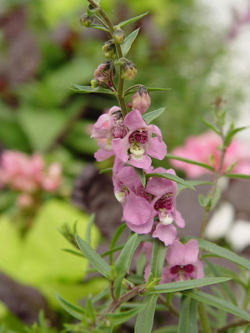Angelonia: Difference between revisions
No edit summary |
No edit summary |
||
| Line 1: | Line 1: | ||
{{SPlantbox | |||
|genus=Angelonia | |||
|Temp Metric=°F | |||
|jumpin=If this plant info box on watering; zones; height; etc. is mostly empty you can click on the edit tab and fill in the blanks! | |||
|image=Upload.png | |||
|image_width=240 | |||
}} | |||
{{Inc| | |||
Angelonia (South American name, angelón, of one of the species). Scrophulariaceae. Perennial herbs or sub-shrubs, grown in hothouses and conservatories, and in the open far South. | |||
Plants with the look of alonsoas: Lvs. simple, opposite (or alternate above): fls. showy, blue, irregularly 2-lipped, the upper lip 2-lobed and the lower larger and 3-lpbed; calyx 5-parted or 5-toothed; stamens 4, in pairs; ovary 2-celled. The axillary fls. are in a long, leafy terminal raceme: branches 4-sided.—About two dozen species from Mex. to Brazil. Grown as pot- plants in warm glasshouses and prop, by seeds or softwood cuttings. | |||
}} | |||
{{Taxobox | {{Taxobox | ||
| color = lightgreen | | color = lightgreen | ||
Revision as of 13:15, 14 January 2010
| Angelonia subsp. var. | ||||||||||||||||||||||||||||||||||||||||||||||||||||||||
|---|---|---|---|---|---|---|---|---|---|---|---|---|---|---|---|---|---|---|---|---|---|---|---|---|---|---|---|---|---|---|---|---|---|---|---|---|---|---|---|---|---|---|---|---|---|---|---|---|---|---|---|---|---|---|---|---|

|
|
| ||||||||||||||||||||||||||||||||||||||||||||||||||||||
| ||||||||||||||||||||||||||||||||||||||||||||||||||||||||
| Standard Cyclopedia of Horticulture |
|---|
|
Angelonia (South American name, angelón, of one of the species). Scrophulariaceae. Perennial herbs or sub-shrubs, grown in hothouses and conservatories, and in the open far South. Plants with the look of alonsoas: Lvs. simple, opposite (or alternate above): fls. showy, blue, irregularly 2-lipped, the upper lip 2-lobed and the lower larger and 3-lpbed; calyx 5-parted or 5-toothed; stamens 4, in pairs; ovary 2-celled. The axillary fls. are in a long, leafy terminal raceme: branches 4-sided.—About two dozen species from Mex. to Brazil. Grown as pot- plants in warm glasshouses and prop, by seeds or softwood cuttings.
|
| Angelonia {{{status}}} Fossil range: {{{fossil_range}}}
| ||||||||||||||||||||||||||||||||||||||||||||||||||||||||||||||||||
|---|---|---|---|---|---|---|---|---|---|---|---|---|---|---|---|---|---|---|---|---|---|---|---|---|---|---|---|---|---|---|---|---|---|---|---|---|---|---|---|---|---|---|---|---|---|---|---|---|---|---|---|---|---|---|---|---|---|---|---|---|---|---|---|---|---|---|
 Angelonia angustifolia | ||||||||||||||||||||||||||||||||||||||||||||||||||||||||||||||||||
| Plant Info | ||||||||||||||||||||||||||||||||||||||||||||||||||||||||||||||||||
| ||||||||||||||||||||||||||||||||||||||||||||||||||||||||||||||||||
| Scientific classification | ||||||||||||||||||||||||||||||||||||||||||||||||||||||||||||||||||
| ||||||||||||||||||||||||||||||||||||||||||||||||||||||||||||||||||
| [[{{{diversity_link}}}|Diversity]] | ||||||||||||||||||||||||||||||||||||||||||||||||||||||||||||||||||
| {{{diversity}}} | ||||||||||||||||||||||||||||||||||||||||||||||||||||||||||||||||||
| Binomial name | ||||||||||||||||||||||||||||||||||||||||||||||||||||||||||||||||||
| {{{binomial}}} | ||||||||||||||||||||||||||||||||||||||||||||||||||||||||||||||||||
| Trinomial name | ||||||||||||||||||||||||||||||||||||||||||||||||||||||||||||||||||
| {{{trinomial}}} | ||||||||||||||||||||||||||||||||||||||||||||||||||||||||||||||||||
| Type Species | ||||||||||||||||||||||||||||||||||||||||||||||||||||||||||||||||||
| {{{type_species}}} | ||||||||||||||||||||||||||||||||||||||||||||||||||||||||||||||||||
| Species | ||||||||||||||||||||||||||||||||||||||||||||||||||||||||||||||||||
| See text. | ||||||||||||||||||||||||||||||||||||||||||||||||||||||||||||||||||
| [[Image:{{{range_map}}}|{{{range_map_width}}}|]] | ||||||||||||||||||||||||||||||||||||||||||||||||||||||||||||||||||
| Synonyms | ||||||||||||||||||||||||||||||||||||||||||||||||||||||||||||||||||
| {{{synonyms}}} |
Angelonia is a genus of about 30 species native to South America. Some species are cultivated as ornamental plants for their snapdragon-like flowers.